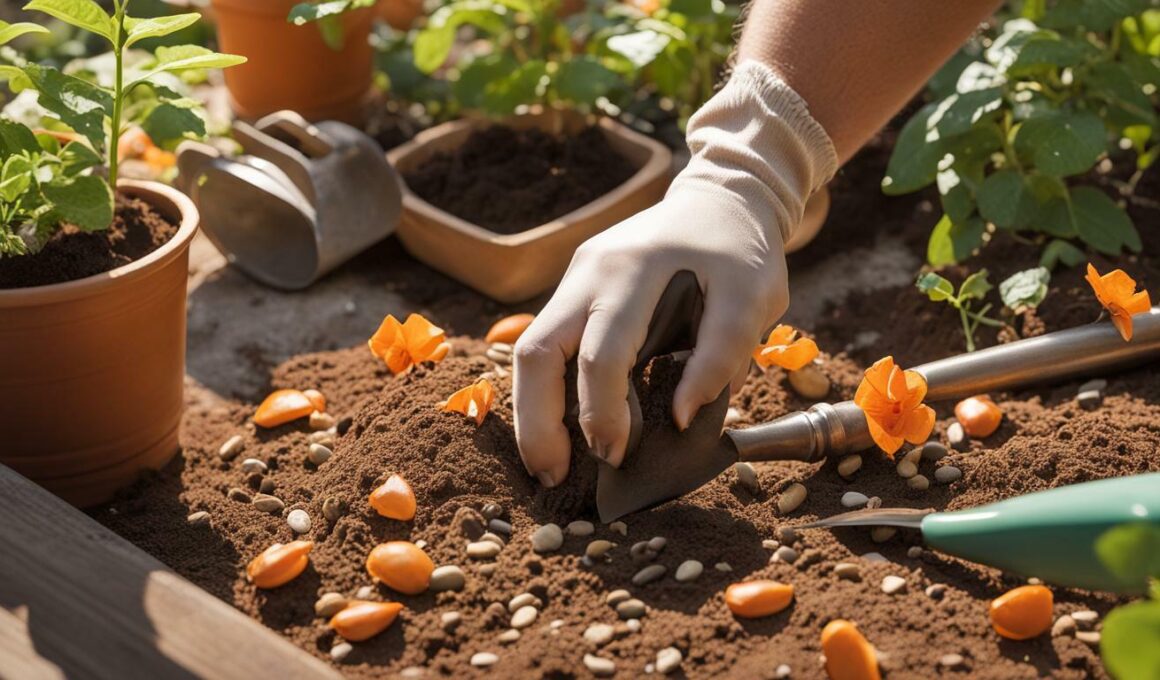If you’re a gardening enthusiast looking to add some color and vibrancy to your outdoor space, starting a trumpet vine from seed may be just the project for you. Not only is it a cost-effective way to grow this beautiful flowering vine, but it also allows for a wider variety of cultivars than those typically found at your local nursery. Plus, there’s nothing quite like the satisfaction of growing something from scratch.
Post Summary:- Starting a trumpet vine from seed is easy and cost-effective.
- Growing from seed allows for a wider variety of cultivars.
- There’s satisfaction in growing something from scratch.
Why Start Trumpet Vine From Seed?
Starting your trumpet vine from seed has many advantages. Not only is it cost-effective, but it also allows for the opportunity to grow a wider variety of cultivars. Plus, there’s the added satisfaction of growing a plant from scratch and watching it flourish.
By starting your trumpet vine from seed, you have the ability to select from a wide variety of cultivars that may not be readily available at a local nursery. This also allows you to experiment with different colors, growth habits, and hardiness levels to find the perfect fit for your garden.
Moreover, growing trumpet vines from seed is a cost-effective alternative to purchasing established plants. By starting from seed, you can save money while still reaping the benefits of a beautiful and vibrant garden.
Choosing the Right Trumpet Vine Seeds
When it comes to selecting trumpet vine seeds, you want to make sure you choose high-quality seeds that will produce healthy and vibrant plants. Here are a few factors to consider:
| Factor | Considerations |
|---|---|
| Hardiness | Look for seeds that are suitable for your climate and can withstand the temperatures in your area. |
| Color | Consider the color of the flowers and foliage you prefer. Trumpet vines come in a range of shades, including red, orange, yellow, and pink. |
| Growth habits | Some trumpet vine varieties grow as vines and others as shrubs, so choose seeds that match your landscape and planting goals. |
It’s worth noting that if you collect seeds from an existing trumpet vine plant, the resulting plant may not be identical to the parent plant. This is because trumpet vine seeds can cross-pollinate with other plants, leading to variations in characteristics like flower color and growth habit. However, this can also result in unique and interesting plants.
Preparing the Soil for Trumpet Vine Seeds
Before you start planting your trumpet vine seeds, it is crucial to ensure that the soil is adequately prepared. This will provide your trumpet vine seedlings with the best chance of thriving.
First, loosen the soil to a depth of at least 12 inches, using a garden fork or tiller. This will aid root penetration, promoting healthy growth.
Next, add organic matter to the soil to improve its fertility and moisture-holding capacity. You can add compost or well-rotted manure and mix it into the soil.
It is essential to ensure good drainage to prevent waterlogging, which can lead to root rot. If the soil is heavy and dense, consider adding sand or perlite to improve drainage.
Once you have prepared the soil, you can plant your trumpet vine seeds. It is recommended to do this in the spring, after the last frost. This will provide your seedlings with optimal growing conditions.
Preparing the Soil for Trumpet Vine Seeds
Here is a summary of the necessary steps for preparing the soil for trumpet vine seeds:
- Loosen the soil to a depth of at least 12 inches
- Add organic matter, such as compost or well-rotted manure, to the soil
- Ensure good drainage to prevent waterlogging
- Plant the trumpet vine seeds in the spring, after the last frost
With these steps, you can ensure that your trumpet vine seedlings have the best possible start, leading to healthy growth and a vibrant garden.
Planting Trumpet Vine Seeds
Now that you have selected the right trumpet vine seeds and prepared the soil, it’s time to plant your seeds! Follow these simple steps:
- Dig a small hole for each seed, about ½ inch deep.
- Space the holes about 4-6 inches apart.
- Place each seed in a hole.
- Cover each seed with soil and gently tamp it down.
- Water the soil until it is moist but not waterlogged.
- Keep the soil moist by watering it regularly, but avoid overwatering which can cause the seeds to rot.
- Place your planter in a warm place with plenty of sunlight.
- Expect to see sprouts in a week or two.
It’s important to note that trumpet vine seeds are sensitive to temperature fluctuations. Keep your planter in a warm, stable environment to ensure successful germination.
It’s also critical to avoid disturbing the soil around the seeds once you’ve planted them. Try not to move the planter or touch the seeds until they have established a strong root system.
With a little patience and care, your trumpet vine seeds will soon grow into beautiful seedlings, adding vibrant colors and sweet scents to your garden.
Caring for Trumpet Vine Seedlings
Now that your trumpet vine seeds have sprouted, it’s important to give them the proper care to ensure their growth and success.
First and foremost, make sure your seedlings are getting enough sunlight. Trumpet vines thrive in full sun, so try to give them at least six hours of direct sunlight per day. If your seedlings aren’t getting enough sun, they may become weak and spindly.
Water your seedlings regularly, but avoid overwatering. You want to keep the soil consistently moist, but not waterlogged. As your trumpet vine seedlings grow larger, you can begin to space out watering sessions.
Fertilization can help your trumpet vine seedlings grow strong and healthy. You can use a balanced, all-purpose fertilizer every two to three weeks during the growing season. Be sure to follow the package instructions carefully.
Pruning is an important part of caring for your trumpet vine seedlings. Regular pruning will help promote healthy growth and prevent the vine from becoming too large and overwhelming your garden. You should prune your vine in late winter or early spring before new growth appears. Cut back any dead or damaged branches, and shape the vine as desired.
Finally, keep an eye out for any pests or diseases that may affect your trumpet vine seedlings. Common pests include spider mites, whiteflies, and aphids. If you notice any signs of infestation, treat your plants immediately with an appropriate insecticide. Diseases like powdery mildew and leaf spot can also be a problem; make sure to keep your seedlings well-ventilated and remove any infected leaves promptly.
With these care tips in mind, your trumpet vine seedlings are sure to thrive and bring vibrant color to your garden.
Can I Use the Same Method to Get a Trumpet Vine to Climb Up a Cedar Post as Starting it from Seed?
Can I use the same method to get a trumpet vine climbing cedar post as starting it from seed? The answer is yes. You can train a trumpet vine to climb up a cedar post by tying it gently with soft twine or garden wire. Make sure to provide adequate support and regularly trim and redirect the vine’s growth to achieve desired results.
Troubleshooting Common Trumpet Vine Seedling Issues
While growing trumpet vine from seed is generally a straightforward process, there are a few potential issues that may arise. Here are some common problems and how to address them:
| Problem | Solution |
|---|---|
| Pests, such as spider mites or aphids, are attacking your seedlings | Try using insecticidal soap or neem oil to control the pests. You can also introduce ladybugs or lacewings to the area, as they feed on these pests. Make sure to remove any affected leaves to prevent the infestation from spreading. |
| Fungal diseases, such as powdery mildew, are affecting your seedlings | Avoid overhead watering and allow for good air circulation to prevent the development of fungal diseases. You can also use a fungicide spray or make a solution of baking soda and water to treat the affected leaves and stems. |
| The soil is too wet or too dry | Make sure to water your seedlings regularly, but avoid letting them sit in waterlogged soil. If the soil is too dry, water more frequently or consider using a mulch to retain moisture. |
| The seedlings are not growing or producing flowers | Ensure that your seedlings are receiving enough sunlight and nutrients. Trumpet vine needs full sun to grow and should be fertilized every few weeks with a balanced fertilizer. You may also need to prune the plant to encourage new growth and flowering. |
By addressing these issues promptly, you can help ensure healthy and vibrant trumpet vine seedlings.
Conclusion
Congratulations! You are now equipped with all the information you need to start growing beautiful trumpet vines from seed. With their stunning flowers and lush foliage, these plants will add a vibrant touch to any garden or landscape.
Remember, starting trumpet vines from seed is an easy and cost-effective way to grow a wide variety of cultivars. By selecting the right seeds, preparing the soil correctly, and caring for your seedlings properly, you can enjoy a bountiful harvest of trumpet vines in no time.
Don’t forget to provide your new plants with plenty of sunlight, water, and nutrients to help them thrive. And if you run into any issues, refer back to our troubleshooting tips to get your trumpet vine seedlings back on track.
So go ahead and start your trumpet vine growing adventure today. With a little bit of effort and patience, you’ll soon have a garden filled with these stunning plants.
FAQ
Q: How long does it take for trumpet vine seeds to germinate?
A: Trumpet vine seeds typically take 10-14 days to germinate, but this may vary depending on growing conditions.
Q: Can trumpet vine be grown in containers?
A: Yes, trumpet vine can be grown in containers as long as they have adequate space for root growth and good drainage.
Q: Do trumpet vines attract hummingbirds?
A: Yes, trumpet vines are known to attract hummingbirds with their vibrant, trumpet-shaped flowers.
Q: How often should I water trumpet vine seedlings?
A: Water trumpet vine seedlings deeply once a week, making sure the soil is moist but not waterlogged.
Q: Can trumpet vine tolerate cold temperatures?
A: Trumpet vine is hardy in USDA zones 4-9 and can tolerate colder temperatures, but it may require protection in severe winters.
Q: When should I prune trumpet vine seedlings?
A: Prune trumpet vine seedlings in late winter or early spring before new growth begins to maintain a neat and manageable shape.
Q: Are trumpet vines invasive?
A: Trumpet vines can be invasive in some areas, so it’s important to monitor their growth and prevent them from spreading uncontrollably.
Q: Can I propagate trumpet vine from cuttings?
A: Yes, trumpet vine can be propagated from cuttings, but it may be more reliable and easier to grow from seeds.









